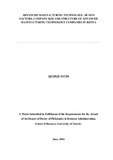| dc.description.abstract | Over the past few decades, manufacturing has evolved from a more labour-intensive set of mechanical processes to a sophisticated set of information based technology processes. With the introduction of various advanced manufacturing technologies (AMTs), more and more functions or jobs are performed by these machines instead of human beings. The major benefits of AMTs include faster machine cycle, greater reliability, reduced inventory, saving on labour, greater flexibility and improved quality. For these benefits to be realized, organizations will require a flexible structure, higher level of skilled labour and higher company‟s capabilities in managing and planning the manufacturing processes. Thus, this study aimed at investigating the nature of the relationship between AMT adoption and organizational structure and if this relationship depended on human factors and company size. A survey was conducted via questionnaires that were sent to all the 183 identified AMT manufacturing companies in Kenya. 101 companies responded positively but 9 companies were rejected on basis of unreliability. Analysis was therefore based on 92 companies. Data showed that all the 92 companies had a measure of investment in at least 2 and at most 9 of the 14 types of AMTs investigated. In general the results showed that the level of AMT adoption in Kenya was very low with investments levels at a mean of 2.057 and integration levels at a mean of 1.639 in a scale of 1-5. The results obtained indicated that at early stages of AMT adoption there was a clear positive relationship between AMT adoption and organizational structure. The study also showed a linear dependence of this relationship on human factors indicating that human factors positively moderated the relationship. The study revealed that when size was measured in terms of capital invested and workforce number it linearized the relationship between AMT adoption and company size. Thus, company size positively moderated the relationship between AMT adoption and organizational structure. From the study a unifying model which cumulated human factors, company size, AMT adoption and organizational structure showed that the joint effect of the predictor variables was different from their individual effect. The study confirmed that the strength of fit between AMT adoption and organizational structure depends on human factors, thus adding to the body of knowledge on contingency theory. This thesis show that successful investment in AMT can allow companies to succeed and remain competitive in the global market and thus encouraging investment in AMTs is a means by which policy makers can protect the capacity and employment levels within manufacturing sector. | en_US |



